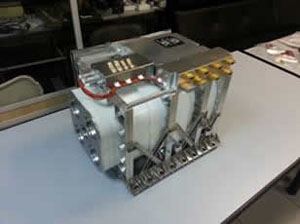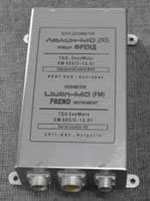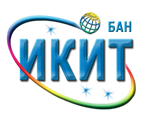First Data From the LIULIN-MO dosimeter aboard the TGO satellite of the ESA-ROSCOCMOS project EXOMARS
 Has ever been a life on Mars is one of the most intriguing questions in space science. To address it the European Space Agency (ESA) and the Russian State Corporation Roscosmos established the ExoMars program for investigating the planet Mars. The program comprises two missions: the first, called ExoMars 2016 consists of the Trace Gas Orbiter (TGO) and an Entry, descent, and landing Demonstrator Module (EDM), also known as Schiaparelli; the second ExoMars mission is planned for launch in 2018 and comprises a rover and a surface science platform.
Has ever been a life on Mars is one of the most intriguing questions in space science. To address it the European Space Agency (ESA) and the Russian State Corporation Roscosmos established the ExoMars program for investigating the planet Mars. The program comprises two missions: the first, called ExoMars 2016 consists of the Trace Gas Orbiter (TGO) and an Entry, descent, and landing Demonstrator Module (EDM), also known as Schiaparelli; the second ExoMars mission is planned for launch in 2018 and comprises a rover and a surface science platform.
On 14 March 2016 at 09:31 GMT the TGO and the Schiaparelli entry, descent and landing demonstrator lifted off on a Proton-M rocket operated by Roscosmos from the Baikonur cosmodrome in Kazakhstan. TGO cruise to Mars will last till mid October 2016. Three days prior arriving at Mars orbit the EDM will be ejected and will land on Mars. After that the TGO will enter into a highly elliptic orbit gradually lowering height until reaching a circular orbit at an altitude of 400 km. In December 2017 the science phase of the mission will begin and will last for about 5 years.
Four science instruments will operate on board the TGO. The Atmospheric Chemistry Suite and the Nadir and Occultation for Mars Discovery are charged with taking detailed inventory of Mars’ atmospheric trace gasses (with concentration less than 1%) with possible biological or geological origin – methane, water vapour, nitric oxides, acetylene etc. The Fine Resolution Epithermal Neutron Detector (FREND) will map hydrogen down to a depth of one metre to reveal deposits of water-ice hidden just below the surface. The Bulgarian-Russian dosimeter Liulin-MO is a part of this instrument. The Colour and Stereo Surface Imaging System will image and characterise features on the Martian surface that may be related to trace-gas sources, which could influence the choice of landing sites of future missions.
In 2012 the Space Research and Technology Institute (SRTI–BAS) received an invitation from the director of the Space Research Institute of the Russian Academy of Sciences (IKI-RAS) Acad. Lev Zelenyi to develop dosimetric instruments for the ExoMars program. A three-lateral project between SRTI–BAS, IKI–RAS and the Institute for Medico-Biological Problems (IMBP) at RAS was signed. The dosimeters are developed and built at SRTI-BAS; the Liulin-MO unit for FREND was paid by IKI –RAS.
The scientific objectives of the experiments with Liulin–MO aboard the TGO and Liulin-ML on the surface platform for ExoMars 2018 are:
- Monitoring during the cruise to Mars, in Mars orbit and on Mars surface the main dosimetric parameters, estimation of the radiation doses in the electronic components and in human body that will be accumulated during future manned missions. Combined with FREND measurements these data will be used for evaluating the full dose from charged particles and neutrons.
- Assessment of the daily and seasonal variations of the radiation parameters in Mars orbit and on Mars surface.
- Comparison of quantities measured in orbit around Mars and on its surface.
- Contributing to the improvment of the existing radiation models in the interplanetary space and on Mars, evaluation of the radiation hazard to the crew on future manned missions.
The first switching on of Liulin-MO on board TGO is planed to take place on 4 –5 April 2016. It will also be the start of data analysis.
The SRTI team who developed and built Liulin-MO is led by Prof. DrS. Jordanka Semkova and Prof. DrS. Tsvetan Dachev with members Stafan Malchev, Plamen Dimitrov, Borislav Tomov, Yury Matviichuk, Assoc. Prof. PhD Rositza Koleva, Venceslav Mitev, Svetoslav Chakarov and Krasimir Krastev.
Photo: FREND with the Liulin-MO dosimeter
AN ISTRUMENT DEVELOPED IN STRI-BAS PARICIPATES IN INVESTIGATIONS OF PLANET MARS
 The first commissioning switching on of the FREND neutron spectrometer and its dosimeter LIULIN-MO on board the TGO satellite was performed on April 6, 2016, from the European Space Operation Center (ESOC) in Darmstadt – Germany.
The first commissioning switching on of the FREND neutron spectrometer and its dosimeter LIULIN-MO on board the TGO satellite was performed on April 6, 2016, from the European Space Operation Center (ESOC) in Darmstadt – Germany.
The TGO satellite of the ESA-ROSCOCMOS project EXOMARS was launched on March 14, 2016 from the Baikonur cosmodrome.
The FREND instrument is designed and built in the Space Research Institute of the Russian Academy of Sciences (IKI – RAS) and the LIULIN-MO dosimeter is developed and built in the Space Research and Technologies Institute of the Bulgarian Academy of Sciences under a contract with IKI – RAS and the Institute for Medico-Biological Problems of RAS.
The analysis of the first LIULIN-MO data shows that the instrument functions normally in all predefined modes. Obtained are data about the radiation environment at about 7.5 millions kilometers away from Earth. The average measured dose from the galactic cosmic rays is 15 microGrays per hour, the average particle flux is 2.9 particles per square centimeter per second.
The commissioning phase of all TGO systems is planned to be completed till April 24, 2016 and then the TGO will begin operating in cruise mode until arriving at Mars. FREND and the LIULIN-MO dosimeter are expected to function during the whole cruise.
Fhoto: The Liulin-MO dosimeter - a unit of the science instrument FREND aboard TGO. Дозиметър “Люлин-МО”, част от научната апаратура “ФРЕНД” Dimensions: 160 х 100 х 45 mm; Weight: 0.7 кg; Power consumption: 3 W; Data rate: 250 kB/day.
